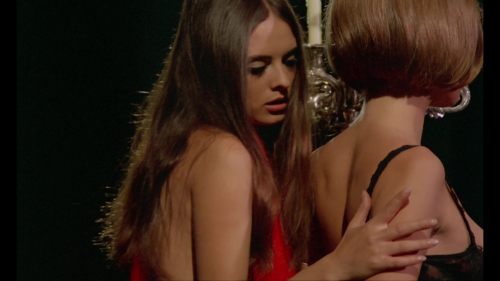Queer Underworld: THE THING (1982)
It’s a common adage that, in fiction, the monster is never just a monster. Horror, science fiction, and fantasy are the venues through which we explore ideas through metaphor and allegory, sometimes unintentionally through the lens of an audience who connects with a work’s themes in a manner specific to them. Such is the case with all manner of LGBTQ cinema, which has often relied on metaphor to smuggle queer themes into cinemas or been subject to queer interpretations after the fact. We at Birth.Movies.Death want to give those queer readings of genre films a voice. This is Queer Underworld.
At first glance, one might not think that John Carpenter’s The Thing would have any queer subtext or allegorical significance to the queer community. It’s a story of roughly a dozen men enclosed in a bottle scenario with a monster, completely devoid of sexual or romantic tension or themes, and the primary emotion displayed by nearly every character is some shade of fear. It’s not a film that speaks directly to the gay experience, nor do I think it was the intention of Carpenter or the novella upon which the film is based to function as a sort of queer analog. So what am I doing talking about The Thing here? Well, it’s not so much what The Thing has to say about queer folks; it’s about what The Thing’s cult popularity says about straight people’s paranoia about queer folks.
The Thing is a film that is top-to-bottom about the paranoid fear that something foreign is hidden amongst the normalcy of a social circle. That normalcy – here portrayed as masculine scientists and their even more masculine helicopter pilot, MacReady (Kurt Russell) – is infiltrated by a literal alien creature, initially disguised as a dog escaping from a Norwegian research station, but ultimately seeking to imitate and assimilate the hegemony of the group and corrupt it from the inside. It’s a creature that wants to hide, to take over every member of the crew one by one with the cover of normalcy protecting it.
So think back to 1982, the year of The Thing’s release. The gay rights movement was about a decade strong, so at the very least large metropolitan areas were gaining awareness of gay men and women as a persecuted class, and the cultural notion of “coming out” had taken shape as the gay community embraced who they were and asked their straight family and friends to do the same. But the early 1980s also saw the emergence of a hidden, mysterious threat to the gay community: the “gay cancer” that would later become known as HIV and AIDS.
The Thing wasn’t a box office smash upon its initial release, but it gained more popularity on home video as the 1980s wore on, which coincided with the rise and proliferation of the AIDS epidemic. Now, I am not saying that paranoia about AIDS and the apparently infectious nature of the gay community was the primary or even a direct cause of The Thing’s post-release popularity, but I do think it speaks to a mindset that would allow such a film to flourish among straight consumers of the era. Going back to the notion of the alien presence hidden within a hegemonic group, is it really so hard to see how paranoia over imitation humans isn’t so far off from paranoia over gay folks imitating straightness where straightness is perceived as the cultural default?
MacReady is almost comically masculinized in The Thing, pouring his drink into the chess computer’s circuits upon losing to its superior strategy. He's beyond audience suspicion of alien conversion because he sports a beard, a stylistic move meant to show his adultness in contrast to Russell’s previous career as Disney child actor. He’s the picture of heteronormative strength and bravado, and he’s fighting a force that changes those around him from being like him to being unlike him. As paranoia pervades the crew, they come across instances again and again where someone is revealed to not be what he appeared, revealing a monstrosity within that strips them of their humanity. As Garry says upon discovering that Bennings was assimilated, “I’ve known him for ten years. He’s my friend.” Now imagine that line in service to the realization that a friend has been in the closet, delivered by someone who views queerness as a form of moral monstrosity in a time when that perspective was popular, and you might see how The Thing might have gained traction in a definitively anti-gay zeitgeist.
This parallel only becomes more apparent when you consider how AIDS was perceived as equivalent with gayness, or at the very least how AIDS was seen as a contagion originating from gay men and caused by the depravity of gay sex. When we first see the body of the alien monster, it is on its side, contorted and grasping as its faces convey grimacing agony. It’s an image that would later be mirrored by images of AIDS victims in hospital beds as their immune systems betrayed them and doctors watched in horror at their own inability to prevent their patients' decline. Fuchs is shown as a burnt corpse in the snow, showing how death is preferable to infection and mirroring the rise in suicide rates by those diagnosed with HIV. The blood-testing scene is not about curing those who have been infected, but is about recognizing that they are too far gone to help and need to be eradicated. The end of the film finds the last remaining survivors willing to sacrifice themselves in order to keep the alien contained rather than let it virulently spread across the world when rescue teams arrive. The film is rife with imagery and themes pertaining to contagion and the terror that accompanies the unstoppable disease, and if there is one fear that characterizes the 1980s, it’s the fear of somehow catching that “gay cancer.”
I want to reiterate that just because The Thing contains parallel messaging to the real-life AIDS crisis does not mean that it was developed as an intentional allegory. To suggest as such would probably be anachronistic, given the relatively few cases of AIDS in the United States as early as 1982 and the time it would take to produce the film from inception to release. What I do want to demonstrate, though, is why a film like this might speak to a particular moment in American history and gain popularity as the decade marched on and the spread of AIDS advanced. The American zeitgeist was predominated by the fear of an unknown disease that was disproportionately affecting a population of people that are visually indistinguishable from the community at large, meaning that not only was the disease worth fearing, but the perceived carriers in effect were the disease, as the Reagan administration’s refusal to acknowledge the epidemic reinforced in the public consciousness. This doesn’t make The Thing a bad movie – far from it, it’s one of the tensest horror films ever made with some of the greatest practical effects work ever put to screen – but it’s worth considering whether the film’s popularity might not be due to more than its intrinsic worth.



